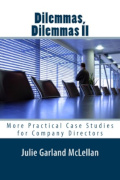|
|
|
|
|
|
|
|
|
Dear reader,
Welcome to the September 2019 edition of The Director’s Dilemma. This month our dilemma is based upon the true case of a start-up board that made a few errors in their succession planning and painted themselves into a pretty tight corner.
During my twenty years’ experience serving on, and consulting to, boards I have seen a lot of dilemmas; all can be resolved when there is goodwill, a degree of skill, and a committed hard-working board of directors. Our three contributors have provided a range of ideas for responding to this issue to help your boards to develop their own responses to succession as needs arise. I hope that you enjoy the insights and find them helpful in extending your governance knowledge.
To read this email in a browser, go to www.mclellan.com.au/newsletter.html and click on 'read the latest issue'.
 Oonagh chairs the audit committee of a fast-growing company that listed last year. The Founder is a charismatic and visionary person who had a great idea and was able to raise capital and engage help to make his idea into a popular product and successful company. Oonagh joined for the IPO and has a background as an audit partner for a big four firm. Oonagh chairs the audit committee of a fast-growing company that listed last year. The Founder is a charismatic and visionary person who had a great idea and was able to raise capital and engage help to make his idea into a popular product and successful company. Oonagh joined for the IPO and has a background as an audit partner for a big four firm.
Just before the IPO the board had a crisis when a couple of the investors and their main broker approached the then chair with a request that the founder be removed from the CEO role as he didn’t inspire trust as a person who could lead a soon to be listed and internationally operating company. At that time the founder had a controlling shareholding. The former chair raised the issue with the founder who didn’t take well to the news. There was a row, the former chair resigned, and the founder became Chair.
This seemed to satisfy the broker and investors. The IPO was a success. The new CEO was great and brought some excellent scale-up experience in a similar industry which added a lot of value.
As is usual, the business model needs to change as the business grows and the limitations of earlier thinking become apparent. Unfortunately, the founder is not open to the need for change and is actively resisting the CEO’s efforts to respond to market needs even though he remains a major shareholder and is risking the company’s survival.
The CEO, other shareholders, and three of the four other directors have asked Oonagh to start a process that will remove the founder from the chair and possibly also the board.
How should she proceed?
|
|
|
|
Andy's Answer
 It’s rare for company founders to maintain control over high-growth publicly listed companies. Those who do are an exception rather than a rule. By incorporating, they create a separate legal entity to themselves. By publicly listing, this usually becomes a Frankenstein’s monster, with a life of its own, existing outside the founder’s direct control. It’s rare for company founders to maintain control over high-growth publicly listed companies. Those who do are an exception rather than a rule. By incorporating, they create a separate legal entity to themselves. By publicly listing, this usually becomes a Frankenstein’s monster, with a life of its own, existing outside the founder’s direct control.
The founder will have invested his Vision. New shareholders may have partially invested into that Vision, too. However, they will mostly have invested into growth potential and creating a return-on-investment as quickly and as frequently as possible. Yet, both the founder and the other faction are joined at the hip. Whenever these two investments can peacefully coexist, that’s a happy coincidence. However, not many founders can take their companies to “the next level” – if they could, they would have done it without the external investors. Equally, not many investors can innovate from scratch – if they could, they would.
Oonagh must carefully navigate two worlds. She should counsel the founder to accept most of his wealth is tied to the ongoing viability of the company. If that is damaged his wealth is damaged, perhaps irretrievably. He’d be wise to accept a loss of control in exchange for a move sideways, perhaps as “Chief Visionary Officer”. The other faction must accept significant reputational damage could result if the founder decides to take this snub personally. The company’s innovation, and perceived market value, could plummet.
It is a good time for cooler heads to prevail.
Andy Cawston is Managing Director of Hartknox, Trustee of Walsh Trust, Secretary of Waitakare Ethnic, and Director of Mangere Family Services Centre. He is based in Auckland, New Zealand.
|
|
|
|
Julie's Answer
 Oonagh must act in the best interests of the company. If she believes a change in the Board Chair is required, she must act. Oonagh must act in the best interests of the company. If she believes a change in the Board Chair is required, she must act.
In theory, she can simply ask directors at a board meeting to vote for a new Chair and take that vote as binding. In practice, this fraught and emotion-laden process must be handled with tact and empathy.
It is a concern when unmet expectations during the IPO process did not trigger education and support. Nobody is perfect; to know of the Founding CEO’s flaw and allow him to become chair without addressing that flaw reflects badly on all directors, not just the Founder.
It takes a special kind of resilient optimism to start a company and grow it to IPO. That same resilience can make for intransigence when the Founder’s vision is challenged by a new focus from his replacement.
Oonagh should give the Founder the courtesy of a private meeting at which she can share the concerns raised.
-
If the Founder offers behaviour modification, she must be prepared with specific measures that will be used. She should investigate getting mentoring to help the Founder to take on the role of chair rather than keep reverting to his former role of CEO.
-
If the Founder is defiant, or if he promises to change but just can’t, then Oonagh should make it clear that he will be voted out of the chair role and, most likely, asked to leave the board. She should be prepared to take this to a special resolution at an EGM if necessary. Hopefully that can be avoided.
-
If the Founder offers to resign, she should make sure that the company has the skills it needs to succeed without him.
Julie Garland McLellan is a non-executive director and board consultant based in Sydney, Australia.
|
|
|
|
Renata's Answer
 Oonagh is in a very delicate position. She was asked to remove the founder and major shareholder from the chair and the board. Oonagh is in a very delicate position. She was asked to remove the founder and major shareholder from the chair and the board.
My first advice is that she should call a board meeting proposing a strategic alignment. She should ask each board member about their understanding of where they are now and what should the next steps be, taking advantage of this meeting to question them about the performance of the current CEO so far and what could be the main obstacles he might be facing to run the company and to lead the changes needed.
In parallel, she should propose search for an external consultancy, an unbiased opinion, to evaluate the board, including the Chair. This should bring to light what is expected from a member of the board and especially what are their boundaries. The Chair is clearly not complying with his role of not interfering in the CEO agenda. The role and responsibilities of a Board Chair should become clearer with the third part assessment. At this time, it is expected that the Founder’s interference come up.
Once the board is aligned and everyone has agreed about what is expected from the Chair role and from the CEO than they would be able to have a proper discussion on the Founder’s behaviour, as well as on the CEO performance. When aware of all the facts they can start assessing if what’s being asked – the removal of the founder – is really the best solution or if they still are able to coach the relationship between the Chair and the CEO, leading to a less radical solution to all stakeholders involved.
Renata Fabrini is Founder at Plongê Gente + Gestão. She is based in Sao Paolo, Brazil.
|
|
|
|
Book Review - Dilemmas, Dilemmas II
 If you enjoy the Director’s Dilemma newsletter, you will love this collection of 25 case studies with suggested answers and a wealth of insights. If you enjoy the Director’s Dilemma newsletter, you will love this collection of 25 case studies with suggested answers and a wealth of insights.
Do you already have it?
Share the love!
This book is the perfect gift for your board colleagues.
Available on amazon.com or amazon.com.au and specialist bookstores.
Julie's News - In August
 On 1 August I spoke to the CPA Director Discussion Group in Sydney about ‘The Conversation between the CEO and Board’. It was a fun and highly interactive session with lots of thoughtful questions and shared insights. On 1 August I spoke to the CPA Director Discussion Group in Sydney about ‘The Conversation between the CEO and Board’. It was a fun and highly interactive session with lots of thoughtful questions and shared insights.
I enjoyed attending, and speaking at, the Better Board Conference in Brisbane. This is always one of the friendliest gatherings of NFP directors each year. I spoke on using the ACNC corporate governance standards to evaluate board and governance performance. If these five standards are how the regulator will hold boards to account then it makes sense to ensure that they are equipped to pass any test with ease when their practices are compared to the standards.
Later in the month I presented the Effective Director course for the Governance Institute in Sydney and I am now looking forward to presenting again in Melbourne in September.
The Worrells Insolvency Seminars are (masochistically) always high on my list of places to learn. In August we considered two real life case studies. One involved a large international trading entity which was still governed by a board consisting of the founder, his wife, and her brother. Nobody in the boardroom with experience of similar scale businesses or the ability to tell the CEO what he needed to know rather than what he wanted to hear. Too often I am asked to help boards that have got into difficulty because they assume that they will be okay and don’t ask for help until they are not. Annual director performance evaluation and board training can save a lot of trouble later on.
I also participated in two webinars, one of ‘Governance Evolution or Revolution” and one called ‘What you don’t know CAN hurt you’ that I will now develop into an online course for NFP directors.
I am always keen to work more and will be delighted to hear from you if you would like to arrange a board strategy workshop, education session, or board performance review! Just call me on +61 411 262 470 or reply to this email for a discussion of how I might help your board.
Inspirational quote for September - This month my favourite quote is:

A note on names - A few readers have asked me where I find the names for the protagonists in each case study; I 'borrow' them from people I meet or things that I read. Oonagh is an old Irish name and means ‘lamb’. Our protagonist must be as gentle as a lamb in her approach to the founder and remaining director on this sensitive issue. She must also be ‘as hungry as a wolf’ to ensure the success of the business. We all wish her luck in her endeavours!
This newsletter - If you have any ideas for improving the newsletter please let me know. If you are reading a forwarded copy please visit my website and sign up for your own subscription.
Advertise With us - Do you have something that could benefit the Director’s Dilemma community? If so, email me for pricing and multi-placement discounts. Get your offerings in front of a premier curated group of Board Directors, Board Advisors, C-Level, and Business Leaders in over 65 countries. The right audience makes all the difference!
Suggestions for dilemmas - Thank you to all the readers who have suggested dilemmas. They are greatly appreciated. I will answer them all eventually. I could not write this newsletter without your help and without the generous help of all the experts who respond each month to the case studies.
Be a contributor - If you would like to attempt a response to the dilemmas for publication you will be most welcome. Simply reply to this email and let me know.
Let's connect - I use LinkedIn to share information about boards and directorship with my friends and acquaintances. If you use LinkedIn and we are not yet connected I will welcome a connection from you. You can find me at linkedin.com/in/juliegarlandmclellan.
Let me help you - If you would like me to speak to or train your board, staff, audience and/or group please contact me at julie@mclellan.com.au.
Farewell until the next issue (due 1 October 2019). I look forward to greeting you again then. In the interim I hope you will enjoy health, happiness and hard work.
Enjoy governing your corporations; we are privileged to do what we do!
Best regards,
Julie
Photo Credits: Personal images in this newsletter are provided courtesy of the contributors, course attendees and conference participants.
Disclaimer:
The opinions expressed above are general in nature and are designed to help you to develop your judgement as a director. They are not a definitive legal ruling and do not constitute legal advice. Names and some circumstances in the case study have been changed to ensure anonymity. Contributors to this newsletter comment in the context of their own jurisdiction; readers should check their local laws and regulations as they may be very different.
Privacy: I am privileged to have your contact details and keep them as safely as possible. I will alert you if they are ever accessed by any unauthorised person (the technical staff at ayuda help with publishing and issuing the Director's Dilemma and have access so they can send the newsletters to you). I do not sell your details to anyone; they are kept only for the intended purpose - sending you this newsletter and helping to build the judgement of company directors by providing a safe way to consider potential responses to real life events.
|
|
|
|
|
|
|
|
|
|
|
|
|
 Oonagh chairs the audit committee of a fast-growing company that listed last year. The Founder is a charismatic and visionary person who had a great idea and was able to raise capital and engage help to make his idea into a popular product and successful company. Oonagh joined for the IPO and has a background as an audit partner for a big four firm.
Oonagh chairs the audit committee of a fast-growing company that listed last year. The Founder is a charismatic and visionary person who had a great idea and was able to raise capital and engage help to make his idea into a popular product and successful company. Oonagh joined for the IPO and has a background as an audit partner for a big four firm.
 It’s rare for company founders to maintain control over high-growth publicly listed companies. Those who do are an exception rather than a rule. By incorporating, they create a separate legal entity to themselves. By publicly listing, this usually becomes a Frankenstein’s monster, with a life of its own, existing outside the founder’s direct control.
It’s rare for company founders to maintain control over high-growth publicly listed companies. Those who do are an exception rather than a rule. By incorporating, they create a separate legal entity to themselves. By publicly listing, this usually becomes a Frankenstein’s monster, with a life of its own, existing outside the founder’s direct control. Oonagh must act in the best interests of the company. If she believes a change in the Board Chair is required, she must act.
Oonagh must act in the best interests of the company. If she believes a change in the Board Chair is required, she must act. Oonagh is in a very delicate position. She was asked to remove the founder and major shareholder from the chair and the board.
Oonagh is in a very delicate position. She was asked to remove the founder and major shareholder from the chair and the board. If you enjoy the Director’s Dilemma newsletter, you will love this collection of 25 case studies with suggested answers and a wealth of insights.
If you enjoy the Director’s Dilemma newsletter, you will love this collection of 25 case studies with suggested answers and a wealth of insights. On 1 August I spoke to the CPA Director Discussion Group in Sydney about ‘The Conversation between the CEO and Board’. It was a fun and highly interactive session with lots of thoughtful questions and shared insights.
On 1 August I spoke to the CPA Director Discussion Group in Sydney about ‘The Conversation between the CEO and Board’. It was a fun and highly interactive session with lots of thoughtful questions and shared insights.